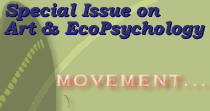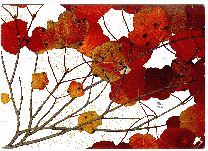

 |
 |
 |
|
Introduction to the Movement Section:
Our kinesthetic sense is stimulated by the elements of the natural world. We are inspired by its movements; leaves in the breeze, fireflies dancing through the dark, fire itself, burning in a blaze, clouds drifting or whipping across the sky, plants growing up out of the earth, fish darting in a stream, our mother’s hands upon our face. The
arts of dance, theatre, and performance call upon our kinesthetic
sense to convey wordless emotions, and subtle understandings. ICE
member Leif Tellman contributes two articles; one prose piece, musing
on a performance piece, 'Rising Beauty', that he was involved in
earlier this year, and another on his work using the language of
movement to help people integrate the energies inside them with
those of the world around them: "Dance Therapy and EcoPsychology". Anima
Mundi is a collaborative partnership between the talented choreographer/dancer
Kathyrn Roszak and her artist/musician husband Christopher Castle
(who is profiled in both the Sound
and Image sections of this
issue). This year they produced a multi-media performance of Gary
Snyder’s poem ‘Mountains and Rivers Without End’
presented at San Francisco’s Magic Theatre. My review of this
event is included here. Red Earth is another magical creative collaboration, between British artists and life-partners Simon Pascoe and Caitlin Easterby. Working with primal energies and elemental forms like clay, ash, water and fire, Red Earth combines movement, sound and sculptural forms to create profound public rituals to invoke and interact with various healing and revitalizing spirits. In
their 1997 piece, ‘Winterbourne’, commissioned by the
environmental group RiverOcean,
Red Earth created an incredible healing ceremony for a stream that
had been choked by pollution. A series of images from that remarkable
performance piece are included here, as well as a description of
another Red Earth project, ‘Outcrop’. Lastly, I have included a report on British artist Stephen Turner’s natural painting/performance piece ‘Tide & Change’, which records the tidal movements in Kent’s Medway estuary (the link between the English Channel and the River Thames). Excerpts from the diary he kept during his 21 days (over the period of one full moon cycle) camping in an abandoned nautical fort in the middle of the estuary are included here, as well as one of the images that resulted from this attempt to capture nature’s patterns directly. |
